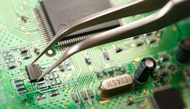Equipment and Tools Required for PCB Repair
Posted by Staff - Soldertraining on Nov 18th 2022
Since the PCB manufacturing and assembly industry is not a zero-defect industry, printed circuit board repair will always be a necessity. Whether at the Production Level or Later, Defects are bound to occur.
Regardless of education, a person who wants to work in the PCB repair industry needs to be able to handle all kinds of electronic devices, disassemble them, and then reassemble them. You must comprehend how electronic circuits operate and the purpose of electronic components to perform PCB repair. You must enroll in PCB Repair Training courses available online and offline for availing better career opportunities.
Equipment and Tools Required for PCB Repair:
To solder and repair a PCB, you will require the following tools and supplies:
A company can utilize a selective soldering machine for mass throughhole PCB rework.
This machine will automatically solder all the components after being placed.Desoldering Pump and Desolder Wire: The solder is melted off the malfunctioning component’s lead wires using a soldering iron. The molten solder is then drawn in with a desoldering pump.
To remove extra solder still left on the board, desolder wire or wick is employed.PCB Holder with Magnifying Lamp: A PCB Holder holds the PCB so that soldering and desoldering can be done easily. To observe microscopic components, some type of magnifying is employed.
Multimeter: A multimeter is sometimes required to troubleshoot defective components.Electronic Repair Tool Kit: A technician can purchase a tools kit that contains everything needed to perform PCB repair instead of buying each tool separately.Soldering Supplies Required:
You will require the soldering supplies listed below:
You would need top-quality solder wire for hand soldering. Lead-free solder wire or solder with lead can be used.
Solder Paste: A solder paste is required for dip soldering. A solder Paste and a Hot Air SMD Rework Station are required to fix SMD components.
Flux is required to clean oxide and other contaminants from component leads and the copper track of the circuit board. A High-Quality Flux is Required.Printed circuit board repair process:
Step 1
Find the defective component. As I mentioned before, learning how a circuit and electronic component function requires expertise. Anyone can do it effortlessly with a little training and instruction.
Step-2
Remove the defective thru-hole component using a soldering iron.
Step-3
Using a solder wick or braid or a vacuum solder extraction tool thoroughly clean the circuit.
Step-4
Put the replacement component in the holes to replace a damaged thru-hole component. There is no need for extra flux if you are using flux-coated solder wire. Do the hand soldering now with the solder wire and soldering iron. If necessary, trim the component’s length to the required length based on the inspection criteria for the given class of assembly.With PCB repair training, you can fix any PCB, including those found in mobile phones, smartphones, tablets, laptops, computer motherboards, televisions, and other PCs worldwide.

